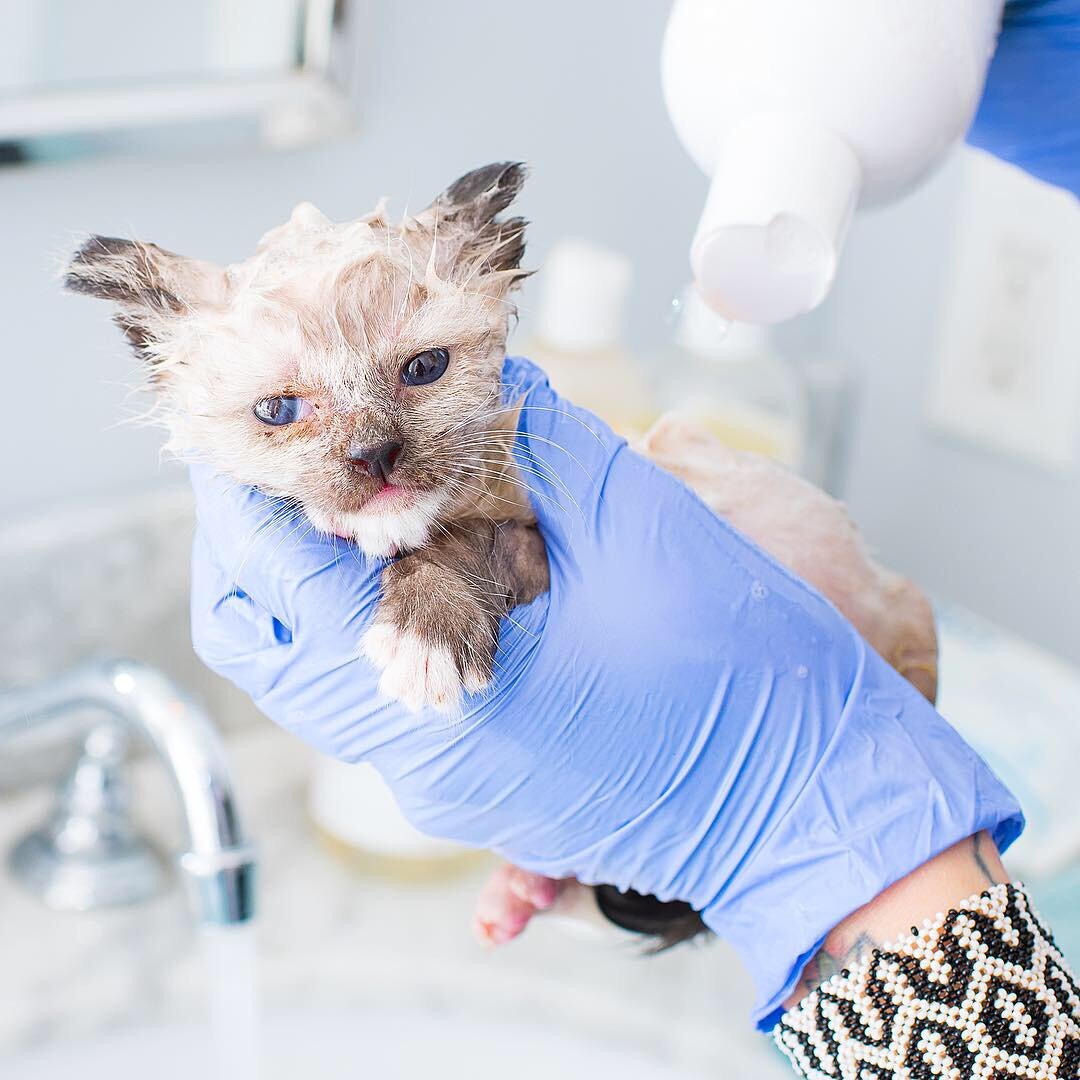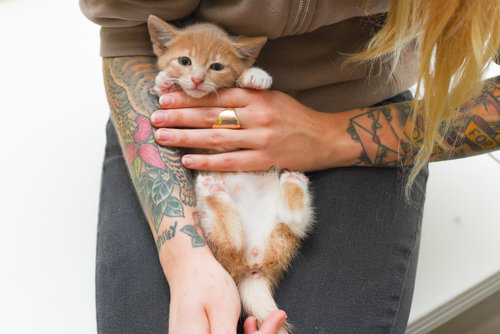Helping Kittens with ringworm
How to help kittens escape the fungal jungle
What is Ringworm?
Ringworm, despite its misleading name, is actually not a worm at all--it is a fungal infection of the skin and hair. This funky fungus preys on the young and immunocompromised, putting kittens at a high risk of infection when exposed. Fortunately, it is totally treatable and kittens can make a full recovery with care. Ringworm is zoonotic, meaning it is contagious to humans, but fear not: with the proper care and sanitization, it can be easily contained to ensure that you and the other animals that share your home stay fungus-free!
While ringworm is not lethal in and of itself, it can be a death sentence for kittens in some shelters. Because ringworm is quite contagious in a high-volume setting, kittens with ringworm are at risk of euthanasia without a foster home that is willing to take them home. If you’re able to save some kittens from the fungal jungle, you should consider signing up to foster ringworm kittens at your local shelter! By dedicating a few weeks of your time to helping kittens through the healing process, you’ll be saving their lives.
Watch Kitten lady’s
Ringworm video here:
How to Detect Ringworm
Ringworm is a fungal infection that typically presents as circular patchy lesions, often seen around the face and paws. If a kitten has bald patches or dry, flaky skin, you’ll want to get her examined by a veterinarian or by your foster coordinator/shelter staff.
A common method for detecting ringworm is to examine the skin under a black light, or a Wood’s lamp. Certain strains of ringworm will glow under a black light, so when you shine it on the kitten, you may see that their bald spots glow bright purple! Use caution with the black light method, as not all strains of ringworm will glow, and some things will glow that are not ringworm, like certain food residue and fibers.
A more effective diagnostic method is a fungal culture called a Dermatophyte Test Medium or DTM. With these tests, the suspected lesions are brushed with a clean toothbrush, picking up samples of the fur and skin. The sample is then tapped into the DTM tray which can rapidly sporulate the fungus, if present. The DTM kit needs to stay in a warm, dark area where it will stay undisturbed. DTM tests are typically done at a veterinarian’s office, but can also be purchased online for the experienced rescuer. Check out this video of a shelter using DTM diagnostic trays in their ringworm unit! These tests can take up to two weeks to process--so it is best to start treatment right away if ringworm is suspected. Being proactive will speed up the process for you and the kitten.
You can also talk to your veterinarian about a ringworm PCR test, which is a highly effective diagnostic test that can determine if your kitten has ringworm.
Protecting Yourself and Your Space
When you have ringworm kittens, you’ll want to protect your environment, your supplies, and yourself to ensure that the fungal spores are not spreading. Whenever coming into contact with the kittens or their space, you will want to:
Use gloves
Wear protective clothing such as a smock or a large shirt and booties/socks
Put your hair up into a bun
Avoid bringing any unnecessary items with you, like cell phones
Put your kittens in a contained space like a plastic playpen that can be sanitized daily. Make sure to only put things that can be washed or disinfected in their space, or use things that are single use and can be easily thrown away afterwards. You’ll still want to give the kittens toys and enrichment of course, but try using plush toys that can be washed, or DIY toys that can be tossed after (check out this video for easy DIY toy ideas!) Be very careful not to let the exposed items touch anything else in your home. Several times a week, change the kitten’s bedding and toys, and sanitize soiled items in a washing machine with hot water and bleach. Completely disinfect the kittens’ area and all supplies using an approved disinfectant. My recommendation is to use a product like Rescue disinfectant.
Medicated Dips and Baths
Twice a week, your kitten will need either a medicated lime sulfur dip or a medicated bath with an anti-fungal shampoo. While lime sulfur dip is traditionally thought of as the go-to treatment for ringworm, it can also be very drying and caustic on the skin, and Kitten Lady recommends considering a medicated Ketohex bath instead, which is equally effective.
Whichever method you choose, be advised that after your dip or bath, the kitten should return to fresh bedding and a sanitized playpen so that she is not reinfected with fungal spores. Ensure that she has fresh toys, bedding, and a comfortable heat pad.
Lime Sulfur Dip Method
Lime sulfur dip is a pungent yellow liquid that acts as a powerful antifungal agent, and it is soaked into the fur and left to dry on the kitten's skin.
Watch a kitten during a lime sulfur dip treatment!
You’ll need:
Gloves
A smock
A spray bottle or garden hose
A sponge cut into small squares
I recommend pouring the lime sulfur dip into a spray bottle or a garden sprayer, which will make it easier to apply. Spray the body, limbs, tail, and paws, getting in between the toe pads. Manually work the liquid into the kitten’s fur, as if lathering your hair while shampooing. You’ll want to use your bathtub or sink for this, and be sure to wear gloves! Never spray a kitten’s head; use a sponge to gently apply the dip to the ears and face, avoiding the eyes, nose, and mouth at all times. When using lime sulfur dip, do not rinse the kitten. Leave the kitten saturated in the dip, which will dry over time. Once the kitten is fully covered, place her immediately into her heated bed so she can stay warm as she dries. Do not leave the kitten in a cool area where her body temperature will drop. Keep her warm!
Medicated Shampoo Method
Anti-fungal shampoos that are obtained online or by a veterinarian can be less caustic and equally effective.
You’ll need:
Gloves
A smock
A sponge cut into small squares
Use warm water to bathe the kitten from the neck down. Wash the kitten with medicated shampoo and lather for five minutes. Use a small sponge to wash the face, avoiding the eyes, nose, and mouth. After five minutes, gently rinse the kitten and towel dry. Place the kitten immediately onto a heat source and fresh bedding.
Watch Archie get a KetoHex bath in this fun “ringworm song” video:
Topical Ointments
In addition to your bath or dip, you’ll want to use a topical ointment. I highly recommend a multimodal approach--so don’t just do a dip or a topical, do both.
There are many topical treatments for ringworm, but you want to make sure that whichever option you are using is effective and safe for cats. The most common topical antifungal is miconazole (yes, that’s the active ingredient in Monistat!) which can be easily purchased over the counter and is very effective at treating ringworm. There are also prescription drugs that can treat both the fungal infection and associated inflammation or irritation, so talk to your veterinarian about the best treatment methods to suit your situation. You’ll want to put on the topical treatment you are using after their bath on the active lesions, and on days where your kitten is not getting a bath or dip you can gently clean the lesions and follow up with the ointment. If you’re unsure about how often you should be giving your kitten ointment, ask your vet!
You may also consider supporting the skin by applying a light layer of topical vitamin E oil as needed (no more than once daily!) to help the skin heal. Vitamin E oil will not treat ringworm, but can help the skin repair itself as it is treated. Talk to a vet about using any topical treatments or vitamins on your kitten.
Oral Medications
While topical medications work from the outside in, oral medications work from the inside out! The most common oral medication is Itrafungol which you can get with a prescription from your vet. When using oral medication, your vet will dose according to your kitten’s specific weight, so watch this video to be sure you know how to pull up the correct dose of a medication. Oral medication is not always necessary for treating ringworm, but it can be effective for some cases when used in conjunction with topical treatments.
To Summarize…
Quarantine your kittens if ringworm is suspected or diagnosed
Sanitize the infected space frequently
Give two medicated baths or dips per week
Clean lesions and apply a topical ointment daily
Give oral medication if prescribed by a vet
Remember, ringworm is totally treatable and should never be a death sentence for any animal! Just like other common issues like fleas, ringworm is totally curable and doesn’t need to be daunting! If you want to be a real hero for the kittens in your community, sign up as a foster parent at your local shelter and tell them you’d like to start fostering kittens with ringworm. With the information you have now, you’ll be able to save their lives and give them a chance to get the loving, fungus-free home they deserve!







